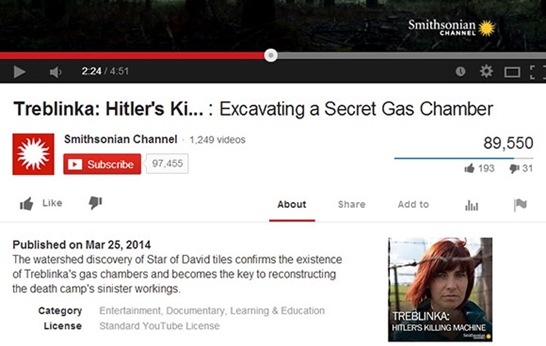New Observer Online
April 15, 2014

The Smithsonian Institutes’ TV documentary division has been severely embarrassed with the revelation that its recently-released “Treblinka: Hitler’s Killing Machine” documentary—which claimed to have “proved” the existence of “gas chambers” at Treblinka because of the discovery of “tiles with Stars of David,” is an extremely amateurish hoax.
The Smithsonian advertised the documentary on its YouTube Channel by saying that “The watershed discovery of Star of David tiles confirms the existence of Treblinka’s gas chambers and becomes the key to reconstructing the death camp’s sinister workings.”
The documentary follows British forensic archaeologist, Dr. Caroline Sturdy Colls, from Staffordshire University and her colleagues as they carry out diggings on the Treblinka camp site in eastern Poland in an attempt to refute Holocaust revisionists who say that the camp was only used as a transit area and not as an extermination center.

The complete lack of any physical evidence that the camp was used for exterminating hundreds of thousands of people, has long been a great source of concern for orthodox historians, to the point where the Jewish Daily Forward newspaper admitted in a 2014 article that the “absence of physical evidence allowed Holocaust deniers to maintain that Treblinka II was a transit, not death, camp.” (“Uncovering the Remains of Treblinka,” Jewish Daily Forward, March 27, 2014.)
The Smithsonian documentary showed Colls and her colleague Ivar Schute digging in a ditch and finding four pieces of ceramic tile.
The narrator of the documentary then announces that “Dutch archaeologist Ivar has just uncovered an orange tile with a Star of David on the base.”

The camera then moves to a close-up of Colls and Schute handling the tiles. Schute tells Colls that he has uncovered “four tiles, three yellow ones and one red one.
“As you see, the Star of David on the bottom, which is quite remarkable,” Schute tells Colls and the camera, then asks her, “But have you ever seen the tiles?”
Colls replies “No” and then Schute goes on to say that these tiles “fit in with the idea that we are in the area of the gas chambers.”
Colls then says what “immediately springs to my mind is that witnesses who were allowed in the gas chamber and the area talked about the Star of David on the outside of the gas chamber building to build up the illusion that people were going to somewhere that was safe.”

On this basis—that tiles had “Stars of David” on them—the narrator of the video then asserts that “Treblinka eye-witnesses have identified tiles just like these.
“Now for the first time, Caroline and her team have hard evidence confirming the existence of the gas chambers,” the narrator adds.
Unfortunately for the Smithsonian, Colls and Schute, the “Star of David” to which they refer is nothing of the sort.
Firstly, the symbol—a six pointed solid star, with a dot in its center, surrounded by a circle, and with a clear “D” letter to its right, is imprinted on the back of the tile—which means that wherever it would have been placed, the symbol would have been cemented onto the floor, and would not have been visible.
This makes Colls’s claim that the symbol was there to “make people think they were going somewhere safe” complete nonsense.

Furthermore, no “eye-witness” has ever claimed that there were Stars of David “inside a gas chamber” at Treblinka—only that there was a large Star of David over the “front door” of the gas chamber.
But, even worse for Colls, Schute, and the Smithsonian, the symbol which they all claim to be a “Star of David” is nothing of the sort.
It is in fact a brand mark of the 125-year old Dziewulski i Lange porcelain factory in Poland. That factory still exists, although it was renamed the Opoczno Terracotta Products Factory in 1950 and is today just called Opoczno S.A.
The company’s symbol is known in the heraldic world as a pierced mullet star, as is not unusual for porcelain marks and coats of arms around Europe.
It borders on the grossly amateurish for so-called “specialist archaeologists” like Colls and Schute to make such a basic error—and for the Smithsonian to then broadcast it to the world as “proof” of a “gas chamber.”

To make matters worse, Colls also knew that the tile was made by Dziewulski i Lange—because she mentioned that on her official website dealing with the excavations.
The farcical documentary does not end there: After excavating for hours on end, the “specialist archaeologists” finally earthed what they claimed were 40 bone fragments, which they immediately pronounced as evidence of “three mass graves.”
The “specialists” then quickly decide to rebury the bone fragments because, as Colls asserts, all they will do is “find more” (an incredibly poor reason to stop the digging). She then claims that these bone fragments and tiles “prove that [the] Treblinka I camp [was] more than just labor camp.” Of course, it shows noting of the sort, and is merely a concoction of a series of ignorant mistakes and ungrounded assumptions.
A few hours later, digging in another spot, this time in the alleged “Treblinka II” camp, some brick and mortar foundations are discovered, and, without any further ado, the Smithsonian narrator announces that the team has “Confirmed the existence of the gas chambers and [has] confirmed their location.”

In reality, nothing of the sort has happened.
All that happened was that the “specialist archaeologists” have completely misidentified a tile brand mark, found what they claimed to be 40 bone fragments, a handful of assorted personal items and some foundations.
These finds do not “prove” anything—and this very poor “scholarship” has not only placed a large question mark over the team’s ability to intelligently interpret data of important historic significance, but will also have added fuel to fire of the revisionists who question the Treblinka story.
